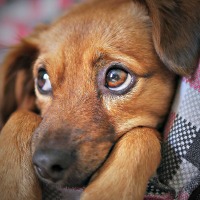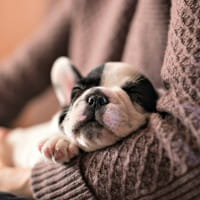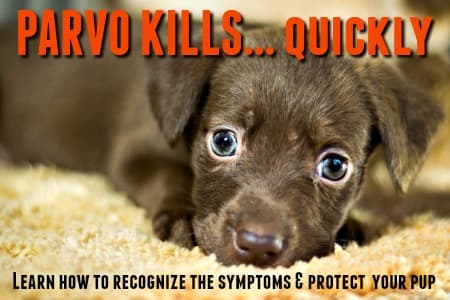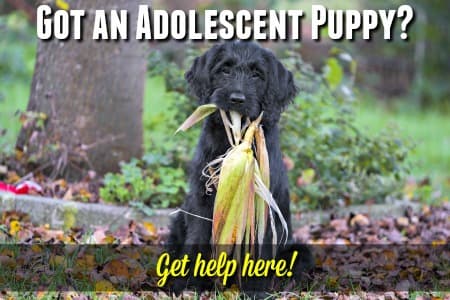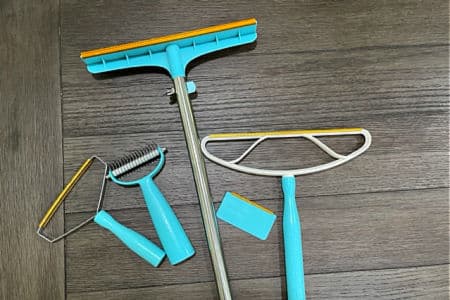FYI: If you buy something through a link on this site I may earn a commission - at NO extra cost to you.
How To Help A Scared Puppy
It's perfectly normal for little Fido to be a scared puppy when you first bring him home.
Put yourself in his shoes (well.. paws!) for a few minutes and you'll understand.
After all he's a baby who has just left his momma, siblings and the only home he's ever known!
Of course all puppies are different. One puppy might be timid and shy at first, while another is bold and adventurous from day one.
Individual personality, breed characteristics and previous experiences all play their roles, and as you get to know your new family member you'll soon find out what his basic temperament is like and how he reacts to new things.
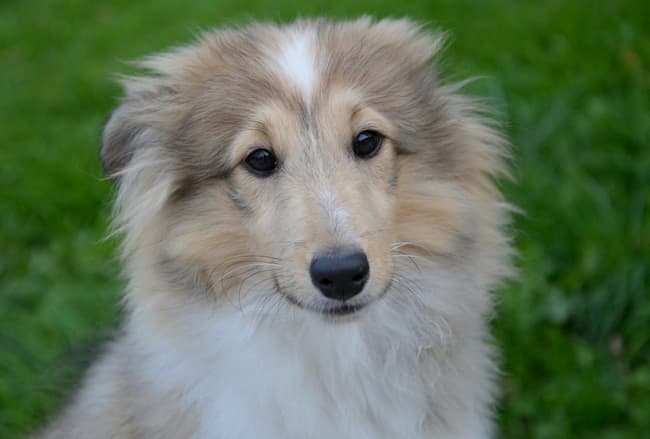
This page looks at:
- The signs which tell you your puppy's scared or overwhelmed.
- What causes of fearful behavior in puppies
- How to help Fido overcome his fears
Mastering these will help you help your pup to grow up to be the confident, friendly dog he's meant to be.
Signs Of A Scared Puppy
Some of the behaviors that a scared puppy will exhibit are obvious signals that he's afraid of something. These include:
- Shaking
- Panting
- Hiding
- Cowering
- 'Freezing'
- Whining
Others are less clear-cut and could be symptoms of illness or pain, but in a pup who seems otherwise healthy and who is showing some of the signs above, chances are they're your pup's way of telling you he's frightened or anxious:
- Loss of appetite
- Sleeping a lot of the time
- Pacing or spinning
- Drooling
- Yawning
Although it's fairly common for a puppy to be anxious when he's left alone, most puppies adjust pretty quickly to being by themselves. Some whining, barking or complaining is perfectly normal, and making a fuss when being crate-trained is also nothing to worry about.
Occasionally particularly anxious or nervous puppies will get hysterical or panicked if you leave them alone, or go out of sight.
This behavior is called Separation Anxiety (SA) and somewhere between 10 and 14% of dogs suffer to some degree.
Luckily there are things you can do to help a puppy who has separation anxiety, plus there are ways to prevent it from starting up in the first place.
SA tends to be more common in pet-shop and puppy-mill puppies, and in older dogs who have been in pounds or shelters (usually these dogs have good reason to be afraid of being abandoned!).
For help with a mature dog who is experiencing SA, check out my Separation Anxiety In Your Dog page.
Another way puppies, and adolescent and older dogs, show that they're anxious or scared is involuntary urination, aka submissive urination.
Note the word 'involuntary' because it's important to realize that this behavior is something dogs have no control over. The pee in an attempt to show submission because they're frightened, anxious, threatened or dominated.
If you've got a pet who piddles when they meet new people or strange dogs, or when they're excited, or the emotional-level around them goes up, then check out this page for more on this common behavioral issue.... Submissive Urination in Dogs
What Scares Your Puppy?
From a 'puppy's-eye-view' just about everything is scary at first!
If you get down on your puppy's eye-level and look around you, it's amazing how big everything looks, so it's not surprising that he's often a scared puppy to begin with.
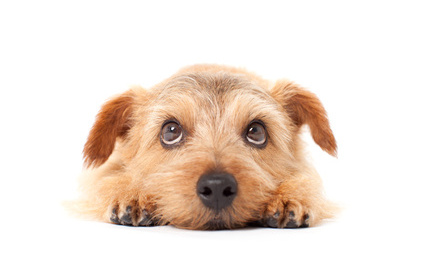
Your new pup has only been alive about 8 weeks, and for the first 2 of those he couldn't see or hear.
So, he's got 6 weeks worth of experience in our world, and until he left his momma to come live with you that experience was probably limited to one house/yard maybe even one room or crate.
There's a big, bright, loud world out there and for a puppy that can be overwhelming at first.
Here are some of the things that are most likely to frighten your puppy (or even an older dog who isn't well socialized, or is naturally a bit anxious:
- Loud noises
- Raised voices
- Sudden movements or waving arms
- The sound of the telephone or TV
- Thunderstorms
- Fireworks
- Vacuum cleaners
- Telephones
- Cars/buses/trains
- Swimming pools
- Other dogs, cats or pets
- Other people - especially those wearing hats, uniforms, bulky jackets or anything that distorts the easily-recognized shape of the human body
Although the things on this list aren't generally dangerous, it's easy to see why your puppy is scared of them.
Loud noises make us jump... even though we KNOW that thunder isn't going to hurt us, or that the vacuum is simply a cleaning tool.
Your pup doesn't have that sort of knowledge and it's natural to be scared of what you don't understand - it's a basic survival instinct.
In addition to these common fear 'triggers', a scared puppy can be anxious or afraid of all sorts of odd things for no apparent reason. Maybe he avoids the reclining chair like the plague, cowers whenever he sees the floor-mop, or hates it when you wear your slippers!
There may be a good reason why he's frightened and often this sort of unexplained fear is related to a previous 'bad' experience with a similar object (this is common in older dogs), but now and then it's just a random instinctive reaction.
Helping A Scared Puppy
The first thing you can do to help calm a scared puppy is to stay calm yourself. Don't get angry or impatient with him, and don't laugh at him either.
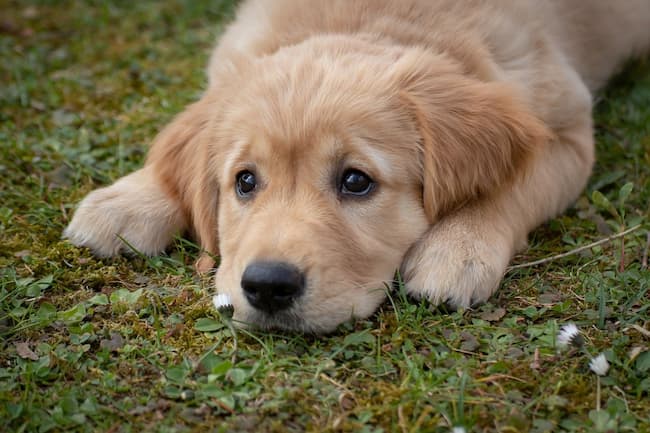
Your pup's fear is real, to him, and he needs you to help him deal with it, not make things worse.
These simple steps can help you create a calm environment and build little Fido's self-confidence, both of which will reduce his fears and make life easier for everyone.
Routine & predictability
Puppies thrive on routine and predictability.
They're creatures of habit and a regular daily schedule of mealtimes, naps, playtime, walks, training sessions etc. will help your new pup to feel secure and speed up the settling in process.
Dial down the chaos
Dogs are emotional, empathetic and very intuitive - they're like sponges which soak up the emotions in their environment.
If your home is hectic and loud, with lots of shouting, running, squabbling and stress, then your puppy is going to be stressed and anxious too.
So, do your best to make sure your home is as calm as possible and keep the volume level down as much as possible.
Keep the kids in check
If you have children, encourage them to walk rather than run, keep their hands by their sides rather than flapping around, to use their 'indoor voices' and resist the urge to scream or squeal.
Fast-moving creatures with high-pitched voices trigger the prey-drive in all dogs, and the herding instinct in sheepdogs, cattle dogs etc.
They can also ratchet up the anxiety and emotional level of your pup.
If you don't want your kids to be chased, tackled or have their ankles and hands nipped by a scared puppy (or one who's in full-on herding mode), it's best not to put temptation in Fido's path!
Don't coddle or spoil your puppy
It might seem counter-intuitive, but it's best not to show a scared puppy too much sympathy!
Yes, you want to be understanding (and it's important not to be angry or upset with him) but cooing and fussing over your little one when he's afraid is more likely to make the situation worse than it is to make it better.
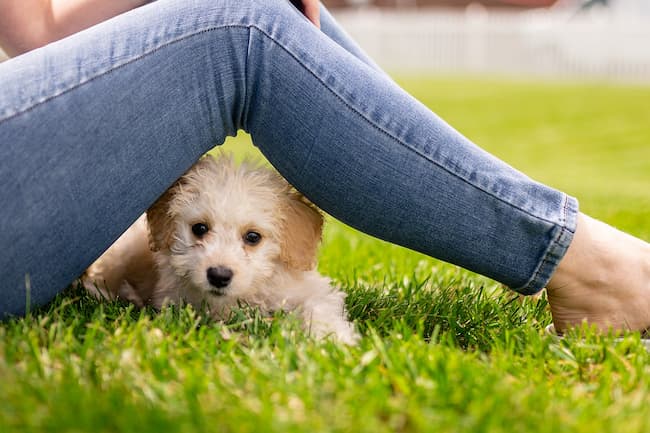
If you make a big deal out of his fears it will only re-enforce his belief that there's something to be scared of.
Instead, be calm and matter-of-fact about whatever it is that is frightening him - your puppy is going to look to you for leadership and will feed off your emotions.
So show him there's nothing to be scared of with your actions, tone of voice and upbeat attitude and don't avoid things that he is scared of.
Obviously you don't want to force him right up next to an object or person that terrifies him, but the only way for anyone, including dogs, to overcome their fears is to face them.
Regular exposure like this will desensitize your pet and reduce his anxiety as the dreaded object/person/situation becomes more familiar.
This type of exposure MUST be pleasant and fun for your pup, or he will get even more scared of whatever it is that's triggering his fear.
So, when you find something that your pup is scared of, slowly encourage him to get close to it (this could take days, or even weeks of s-l-o-w progression).
Don't force or rush him, but encourage him with treats, praise and a bright, happy, unworried attitude and voice.
Every time he gets a little closer, make sure he knows that you're pleased with him.
Patience is essential when you're dealing with a scared puppy, but it's worth the time and effort involved.
A scared puppy still needs regular socialization
The more exposure your puppy has to new people, places, animals, noises and so on the better.
Giving your pup these experiences is called 'socialization' and it's something that you need to start just as soon as you can, and continue throughout his lifetime.
Socializing your puppy is an important part of your parenting responsibilities but it shouldn't be a chore.
Until your pup has had all of his vaccinations you'll need to make sure he only visits family or friends who have fully vaccinated dogs, and that he stays well away from any public areas where unvaccinated dogs have been.
This is to protect him from potentially deadly diseases such as Parvovirus.
You can take him out and about in your car, and even on trips to the petstore or park, but when he's in a public place keep him in a puppy carrier or your arms so that he's up off the ground and safe from contaminated areas.
Once his shots are all taken care of the sky's the limit and you want to give him as many varied socialization experiences as possible.
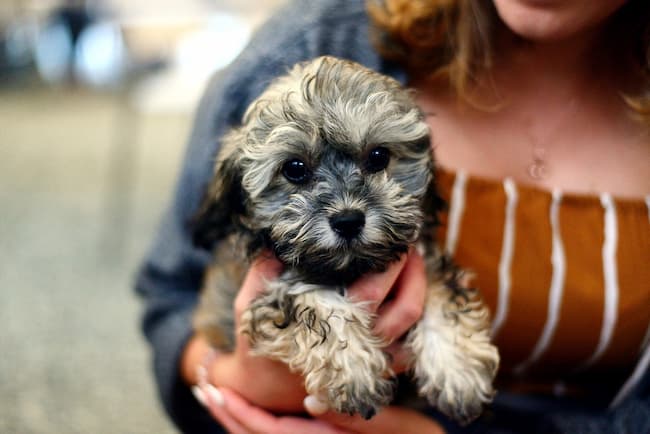
These outings should be fun, for both of you, take it slowly and let your puppy set the pace, but make sure that this becomes a regular part of your routine.
Socialization can be a bit more of a challenge for a scared puppy than it is for a confident one, but that only means it is doubly important to make sure that Fido gets the chance to grow his self confidence in this way.
To get you started off right, check out my Puppy Socialization Checklist for suggestions, ideas and creative ways to help your pup build self-confidence no matter where he is, or who is around him.
Build self-confidence with puppy training
A scared puppy is often generally lacking in confidence, and a great way to help overcome that is to make sure your pup gets plenty of positive training sessions and that he succeeds and is rewarded for that success.
Basic puppy training sessions can begin at home right away, and once he's had all his puppy shots I strongly recommend enrolling your little one in a basic puppy class at a local dog obedience school.
This is a great way to improve the communication and bond between you, build self-confidence and competence in your pup, and give him a very valuable socialization experience in a controlled setting. It's a win-win all around.
Only ever use positive, rewards-based training methods and make the sessions short and fun, because puppies have very short attention spans and will only want to repeat things that are enjoyable.!
Extreme Fear & Phobias In Puppies
All of the above has been focused on your average scared puppy, one who's afraid of the usual things and makes a bit of a fuss when left by himself.
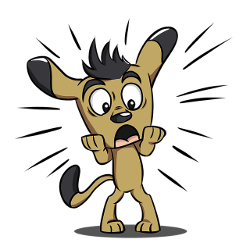
The tips and advice I've given will help you reduce this sort of anxiety and help your pup to become more confident and much braver as he matures and develops physically, emotionally and socially.
But there are a few (and I mean a FEW) puppies who are so highly-strung or anxious that they are neurotic, hysterical and prone to obsessive-compulsive behavior.
This is more common in some breeds than others, herding dogs, hunting dogs and other working breeds tend to be more at risk of this and it tends to run in bloodlines, where it's a genetic disposition.
Working dogs bred solely for field-trials, protection and other similar tasks, while not afraid or fearful in this way, can still be much too 'high-drive' which LOOKS like neurotic, over-the-top type behavior and be too much for your average pet owner to handle.
Separation anxiety (which I've discussed towards the top of the page with links to more detailed resources) is just one of the more extreme types of anxiety.
Other signs of phobias, neuroses and extreme anxiety include obsessive tail chasing, spinning, chewing (not just the carpet, but the door, walls, window frames, flooring etc.), vomiting or diarrhea, constant motion or incessant barking and even fainting from pure hysteria and terror.
This is pretty rare in dogs, and extremely rare in puppies, but if you do have a pooch that acts this way in response to a certain fear trigger, you need to talk with your vet and a dog behavioral specialist so that you can find the best way to help your pet overcome his fears.
Life is miserable for a scared puppy or dog who feels terrified either occasionally, or often... and it's not much fun for the people who love him either.
Fear-bases Aggression In Dogs
Lastly, let's take a quick look at the worst aspect of a puppy or dog's fear - that he will react aggressively in an effort to protect himself from the perceived threat.
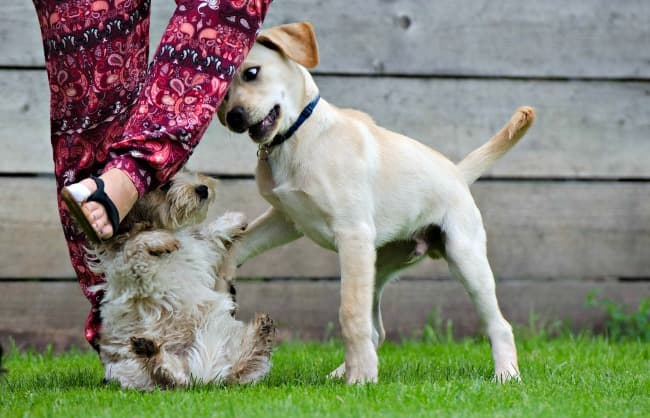
Now, if this manifests itself as your pup biting the vacuum cleaner every time he sees it, not such a big deal.
BUT if he snarls and snaps at every person he passes who's wearing a hat, or at the neighbors toddler who's running and squealing, then you have a real problem with potentially tragic consequences.
The fight-or-flight mechanism is deep rooted in all living creatures, and when faced with something we're scared of we instinctively choose whether to stand up to the threat or to run away.
Most dogs will choose to run away rather than fight if that's possible - or they'll freeze because they're so scared they simply can't think or move.
The problem occurs when your scared pup can't run away - for example if he's cornered by a child who wants to pet him even though he's clearly frightened, or he's physically forced to get too close to something that is scaring him.
In these situations he's likely to growl, snarl, snap or bite because he's literally scared out of his wits. Fear-based reactions are unpredictable and the most dangerous type of aggression because it can blow up out of nowhere and with very little (if any) warning.
It's also often in response to something that isn't normally seen as scary, so the fear and it's result is unexpected.
Again, if your puppy reacts this way you need to get professional help so that you can understand what's happening and work towards a solution that will help your pup fees safe and confident which will take away the need for him to defend himself in this way.
you might also like...
- Home
- First Days At Home
- A Scared Puppy
FTC Disclosure: Some pages on this site contain affiliate links. I may earn on qualified purchases.

